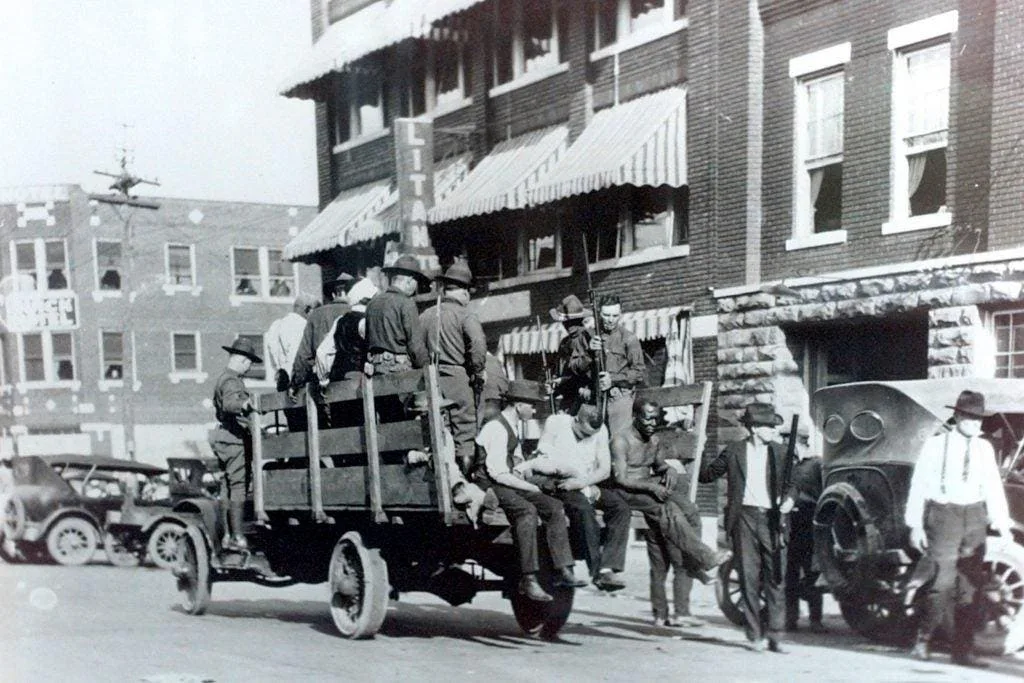
It would almost be funny if it weren’t so sad.
Oklahoma’s state school superintendent Ryan Walters actually said that the infamous Tulsa race massacre in the Greenwood District of the city (one of the most prosperous African American communities in the U.S. in the early 20th century, often referred to as “Black Wall Street”) was not racially motivated. In a public forum last Thursday, Walters stated that teachers would be allowed to include the 1921 massacre in their curriculum but they should not “say that the skin color determined it”.
First, here is the official record from the Tulsa Historical Society:
On the morning of May 30, 1921, a young black man named Dick Rowland was riding in the elevator in the Drexel Building at Third and Main with a white woman named Sarah Page. The details of what followed vary from person to person. Accounts of an incident circulated among the city’s white community during the day and became more exaggerated with each telling.
Tulsa police arrested Rowland the following day and began an investigation. An inflammatory report in the May 31 edition of the Tulsa Tribune spurred a confrontation between black and white armed mobs around the courthouse where the sheriff and his men had barricaded the top floor to protect Rowland. Shots were fired and the outnumbered African Americans began retreating to the Greenwood District.
In the early morning hours of June 1, 1921, Greenwood was looted and burned by white rioters. Governor Robertson declared martial law, and National Guard troops arrived in Tulsa. Guardsmen assisted firemen in putting out fires, took African Americans out of the hands of vigilantes and imprisoned all black Tulsans not already interned. Over 6,000 people were held at the Convention Hall and the Fairgrounds, some for as long as eight days.
Twenty-four hours after the violence erupted, it ceased. In the wake of the violence, 35 city blocks lay in charred ruins, more than 800 people were treated for injuries and contemporary reports of deaths began at 36. Historians now believe as many as 300 people may have died.
To remove race from this literal race massacre is, as Alicia Andrews, chair of the Oklahoma Democratic party, said, “ridiculous. . . how are you going to talk about a race massacre as if race isn’t part of the very cause of the incident?” Andrews asked.
As the great Spanish-American philosopher George Santayana originally said, “Those who cannot remember the past are condemned to repeat it.” That saying later morphed into “those who fail to learn history are doomed to repeat it.” By advocating for an ostrich-like educational approach where history is literally “whitewashed”or even re-written, Ryan Walters and others such as Florida governor Ron DeSantis put us in danger of repeating our sometimes very ugly past.
So what would be a better approach and where can we find it? I propose that we look to both Germany and South Africa for models of how to teach about America’s history when it comes to race relations.
In Germany, the history of Nazism and the Holocaust is taught with particular commitment and fervor, an approach the Germans call Vergangenheitsaufarbeitung, a word that roughly translates to “working off the past”. It has taken many years of following this approach for the country to come to terms with its dark history. As the philosopher Susan Neiman notes (in a wonderful New Yorker article), Germany today is certainly not free from either racism or anti-Semitism, “but its culture and politics remain deeply informed by its history. All of the arts, including TV and film, regularly refer to and treat Nazi history. And the country regularly takes time for what Neiman calls ‘public rites of repentance’ around events such as the liberation of Auschwitz, Kristallnacht, and the end of the war. Then there’s the iconography: the Holocaust Memorial sits at the center of a reunified Berlin. There are also the famous ‘stumbling stones’—small brass plaques placed throughout the city to mark where Jews and other victims of the Nazis last lived, before they were deported. By comparison, Nieman writes, ‘Imagine a monument to the Middle Passage or the genocide of Native Americans at the center of the Washington Mall. Suppose you could walk down a New York street and step on a reminder that this building was constructed with slave labor.’” Such stark reminders of our original sin are indeed hard to imagine in the United States.
South Africa’s horrible history of racial oppression and discrimination under apartheid has also been directly addressed through the “Truth and Reconciliation Commission” which was “set up by the Government of National Unity to help deal with what happened.” As Dullah Omar, South Africa’s former Minister of Justice stated, that country’s commission was a “necessary exercise to enable South Africans to come to terms with their past on a morally accepted basis and to advance the cause of reconciliation.” Again, imagine such a commission being set up by the US Government to deal with our history of slavery, inequality, oppression and discrimination. And imagine the outcry that would ensue.
Ryan Walters and many conservative parents across the country are apparently afraid that teaching any lessons about racism amount to promoting “critical race theory” (an idea whose origins and aims most people don’t even understand) and that such an approach will make white kids feel bad about themselves. I would argue that our kids—whatever their color—are not as fragile as people might think, nor should they be sheltered from the truth. It’s time to follow the example of Germany and South Africa and shine a bright light on the sins of the past. Otherwise, we may indeed be doomed to repeat them.

